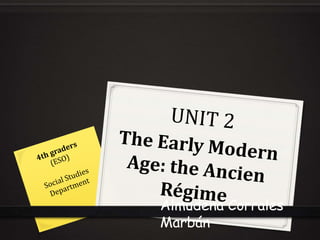
Unit 2 the early modern age ancien regime
- 2. VOCABULARY NEW WORLD ANCIEN RÉGIME TO EXERT PRINTING PRESS OTTOMAN TURKS TREATY CURRENCY CORTES PROTECTIONIST REFORMATION COUNTER-REFORMATION https://quizlet.com/almusociales Almudena Corrales Marbán FIND THE SPANISH WORD !
- 3. 1. The importance of the Early Modern Age (1492-1789) During this period, a series of political, economic and social changes brought about the establishment of a system historians call the ANCIEN RÉGIME (ANTIGUO RÉGIMEN). These changes including significant advances were: Europeans’ discovery and conquest of new lands redefined the limits of the known world. Europeans monarchs became more powerful, exerting their power over feudal lords. New forms of skilled craftmanship and increased trade over the world created a more open economy. Johannes Guttenberg’s invention of the printing press in 1440 facilitated an exchange of information.
- 5. 2. The Age of Discovery The fall of Constantinople to the Ottoman Turks in 1453 interrupted traditional transport and trade routes between Europe and Asia. As a result, European traders could not import silk, gold, spices and other luxury goods from the East.
- 6. NEW ROUTES TO EAST ASIA In the 15th century, Spain and Portugal started making voyages to find alternative routes to Asia. These explorations were successeful because of three factors: 1. Spanish and Portuguese navigators already had a lot of experience sailing along the coasts of Africa. 2. They had ships, such as caravels, which were well designed for long ocean voyages. 3. Compasses and more accurate maps were helped them to navigate
- 10. 3.Monarchy during the Early Modern Age In this period there were three types of monarchy. Some monarchies were authoritarian, while others were absolute. In England a parlamentary monarchy was established in the 17th century.
- 11. 3.1. AUTHORITARIAN MONARCHY Monarchs in the 16th century are describe as ‘authoritarian’ because they had forced the nobility to accept their authority. However, these monarchs also had to respect institutions that were able to limit their power, such as the Cortes in Spain of the Estates General in France. These monarchs implemented various measures in order to govern their kingdoms more effectively: They unified all the territories that were under their control. They established administrative unity for the entire kingdom. They created royal armies to end their dependence on the nobility for military support.
- 12. In Spain authoritarian monarchy was established by the Catholic Monarchs, who expanded their kingdoms to include territories in Italy, North Africa and the New World. In the 16th century, the authoritarian monarchy was consolidated by Carlos I (1516-1556) and his son Felipe II (1556- 1598). In this period, Spain also became global imperial power, with posessions in the New World, Africa and Asia.
- 13. 3.2. ABSOLUTE MONARCHY In the 17th century, absolute monarchy came to predominate in Western Europe. It was called ‘absolute’ because the crown had unlimited authority which was believed to come from God. Absolute monarchs exerted this authority in various ways: they did not allow representative bodies which could limit crown’s power they controlled the government and economy of their kingdoms they expanded the army to increase their control SPAIN’S POLITICAL DECLINE In this period Spain’s power began to decline with the reigns of the Lesser Hapsburgs (Austrias Menores) Felipe III, Felipe IV and Carlos II, who left their government in the hands of the validos. The causes of this decline include Spain’s defeat in the Thirty Years War.
- 15. 3.3. PARLIAMENTARY MONARCHY In England, there was a civil war in the 1640s between supporters of the king and the supporters of Parliament. As a result, the absolute monarchy was replaced by a republic under the control of the former Parliamentarian commander Oliver Cromwell. After Cromwell’s death, the absolute monarchy was restored, but it only lasted until the Glorious Revolution of 1688. This led to the establishment of a parliamentary monarchy- with William of Orange and Queen Mary- in which the monarch’s power were limited by the Parliament. In 1689 the Bill of Rights established the need for regular parliaments, and stated that the monarch could not imposed taxes without Parliament’s consent.
- 16. 4. Exchange and global trade
- 17. 5. ART Renaissance art developed during the 15th and 16th centuries. The name of this style refers to the rebirth of Ancient Greek and Roman traditions in art and architecture, such as the importance of proportion and an absence of excessive decoration.
- 18. Baroque style was popular in Europe during the 17th and early 18th centuries. The name of the style may come from the Portuguese word which describes an irregular or rough pearl. This style is characterised by natural forms an abundant decorative elements, which created a sensation of drama and movement. In Catholic countries, absolute monarchs used Baroque art to affirm their religious doctrine and political power. Bernini, Baldaquino en San Pedro del Vaticano, Roma, 1623-34. (28, 5 m high)